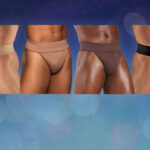Choosing the right fabric for your Salsa Dancing Dress is crucial. It’s not just about aesthetics; the fabric impacts your comfort, movement, and confidence on the dance floor. I learned this lesson the hard way early in my dance career.
Back in 1989, fresh out of architecture and visual design studies, I was diving headfirst into professional ballroom dancing. Preparing for my first major competition, the U.S. Ballroom Championships, I poured all my energy into creating a striking Rhythm dance dress. Inspired by haute couture, I designed a black and white, asymmetrical dress with Fortuny pleating and dramatic black fans. I even splurged on custom-pleated white silk. I was immensely proud of its fashionable and intricate design.
 Teresa Sigmon ballroom dance dress sketch fortuny pleating
Teresa Sigmon ballroom dance dress sketch fortuny pleating
However, my excitement quickly turned to dismay. In those pre-internet days, I didn’t realize that haute couture styles weren’t the norm in ballroom dance. Worse still, I hadn’t considered how white fabric and extensive pleating could make me appear larger – the opposite of what I wanted after working hard to lose weight for the competition.
After the first round, a judge approached me, visibly upset. Gesturing at my dress, he exclaimed, “Why are you wearing white? It makes you look heavy, especially after you’ve lost weight!”
Devastated and embarrassed, I threw the dress away immediately after returning home. All the effort, money, and countless pricked fingers felt like a complete waste, even worse. I loathed that dress. The judges clearly did too. Five dances were all it lasted.
That experience was a harsh but valuable lesson: fabric color and texture can dramatically alter your appearance. White, I discovered, is the least flattering color if you want to look slimmer. The Fortuny pleating and fans only amplified the issue, adding volume to my frame. My attempt to look my best had backfired spectacularly due to poor fabric choices.
This early dance disaster taught me a crucial lesson that applies directly to choosing fabrics for a salsa dancing dress: fabric choices truly matter.
Understanding Stretch Fabrics for Dance Costumes
When creating a salsa dancing dress, or any dance or ice skating costume, understanding the dos and don’ts of stretch fabrics is essential. Choosing the right stretch fabric can elevate your design and help you achieve your desired look, enhancing your performance and confidence.
Let’s explore key fabric considerations to ensure your salsa dress is both stunning and flattering.
Light vs. Dark Colors for Salsa Dresses
Color is one of the most impactful elements in a salsa dancing dress. The right color can enhance your silhouette and complement your skin tone.
If your goal is to appear slimmer on the dance floor, opt for medium to darker shades. Darker colors have a slimming effect, creating a more streamlined look under the bright lights of the dance floor. Think rich blacks, deep reds, vibrant blues, and emerald greens – all popular and flattering choices for salsa dresses.
Conversely, if you are petite or desire to appear fuller, lighter colors can work to your advantage. Pastels, whites, and metallics can add volume. However, for salsa, which is often about dynamic movement and powerful expression, darker, more saturated colors tend to be more impactful and forgiving.
For deeper insights into color theory and choosing the best colors for you, explore resources on color typing. Understanding your personal color palette can further refine your salsa dress choices.
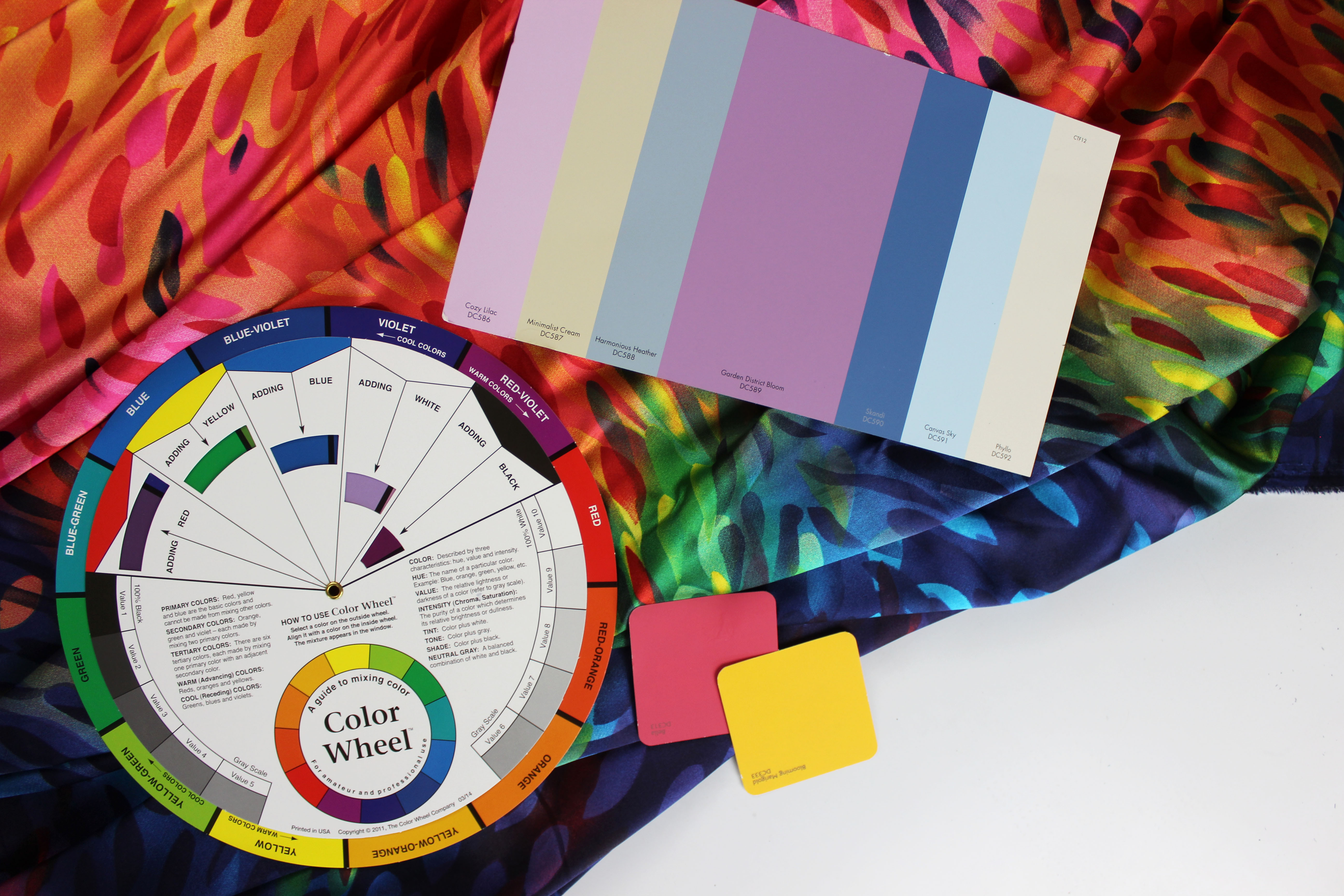 Color swatches in light and dark shades, demonstrating the effect of color on perceived size, relevant to salsa dancing dress fabric selection.
Color swatches in light and dark shades, demonstrating the effect of color on perceived size, relevant to salsa dancing dress fabric selection.
Shiny vs. Matte Stretch Fabrics for Salsa Movement
Beyond color, the choice between shiny and matte stretch fabrics significantly impacts the look and feel of your salsa dancing dress.
Matte stretch fabrics are generally versatile and flattering for most dancers. They offer a neutral base that can create a lengthening and slimming effect, especially when combined with strategically placed accents. Matte fabrics allow embellishments like rhinestones to truly shine.
 Long line Latin dress with matte stretch crepe and chainette fringe, showcasing a flattering silhouette for salsa dance.
Long line Latin dress with matte stretch crepe and chainette fringe, showcasing a flattering silhouette for salsa dance.
Consider using a matte stretch crepe for your salsa dress as a foundation. It drapes beautifully, moves with you, and provides a sophisticated backdrop for bolder design elements.
Shiny fabrics, on the other hand, tend to add visual volume. Fabrics like metallic foil, sequins, hologram fabrics, and crushed velvet catch the light and can make you appear larger. While these can be incredibly eye-catching and perfect for the vibrant energy of salsa, they should be used thoughtfully.
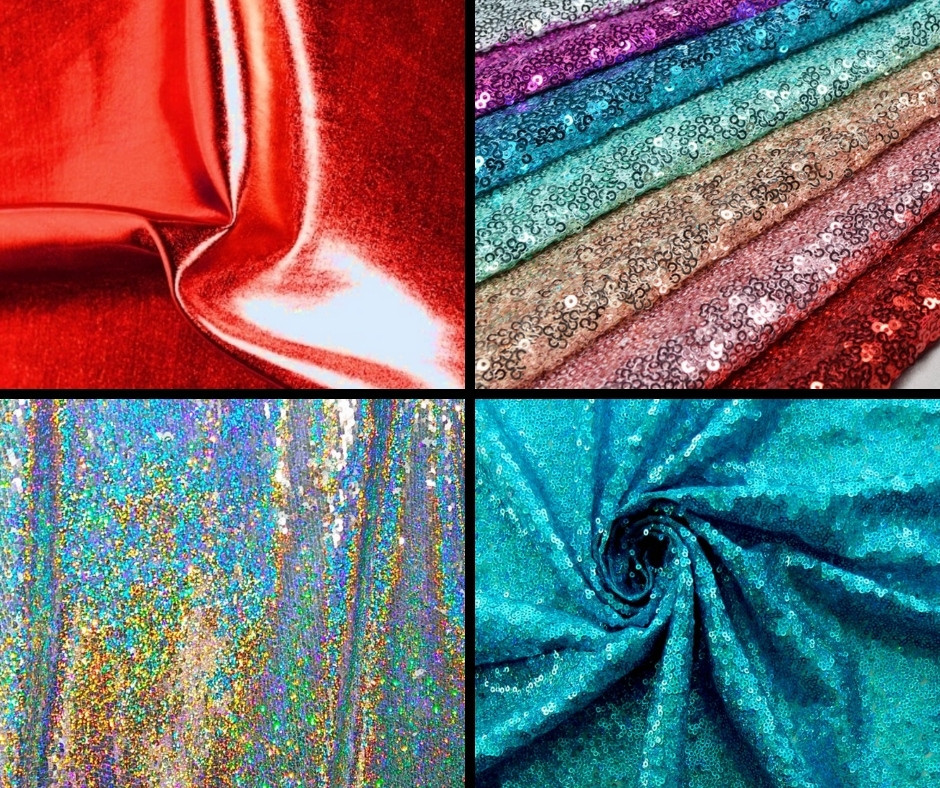 Examples of shiny liquid foil and holographic sequin fabric, showcasing options for accent details in a salsa dancing dress.
Examples of shiny liquid foil and holographic sequin fabric, showcasing options for accent details in a salsa dancing dress.
If you love the sparkle of shiny fabrics but want to maintain a streamlined silhouette for your salsa dress, use them as accents. For example, incorporate shiny fabric in fringe, appliques, or skirt details while keeping the main body of the dress in a matte fabric.
 Example of a velvet Latin dance costume with shiny mesh inserts and crisscross straps, illustrating balanced use of shiny and matte fabrics.
Example of a velvet Latin dance costume with shiny mesh inserts and crisscross straps, illustrating balanced use of shiny and matte fabrics.
Fringe itself can also be matte or shiny. Chainette fringe offers a matte texture, while metallic fringe provides shimmer. Rhinestone fringe is another option to add sparkle without the volume of fully shiny fabric.
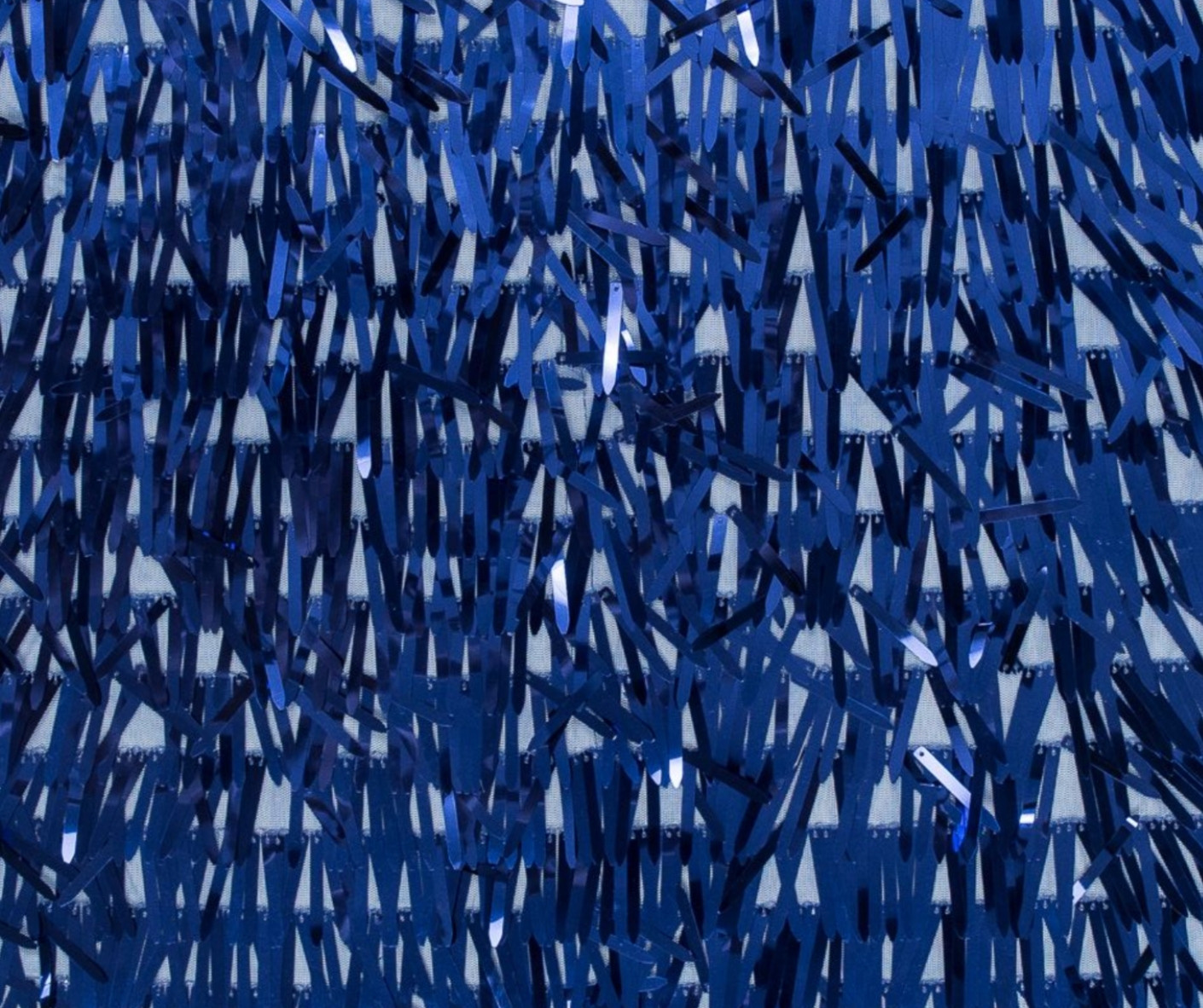 Shiny metallic fringe detail, an example of using shiny accents in salsa dance costumes.
Shiny metallic fringe detail, an example of using shiny accents in salsa dance costumes.
Strategically placed rhinestones on a matte fabric can offer sparkle and a slimming effect. Consider using matte stretch fabric as the base of your salsa dress and adding a rhinestone design to enhance your shape.
 Example of matte stretch fabric with a slimming rhinestone design, ideal for a flattering salsa dress with sparkle.
Example of matte stretch fabric with a slimming rhinestone design, ideal for a flattering salsa dress with sparkle.
Stretch Velvet in Salsa Dress Design: Dos and Don’ts
Stretch velvet is a luxurious fabric choice for a salsa dancing dress. Generally considered a matte fabric (unless it’s crushed velvet, which is shiny), velvet offers richness and depth.
Most dancers can wear stretch velvet beautifully. However, consider the weight and nap of the velvet. For salsa, a lightweight velvet with a shorter nap might be preferable to avoid overheating and maintain freedom of movement. Conversely, a thicker velvet can add more visual weight and warmth if desired.
 Julie Vincent wearing a purple velvet Latin dress, showcasing the elegance and drape of velvet for salsa dance.
Julie Vincent wearing a purple velvet Latin dress, showcasing the elegance and drape of velvet for salsa dance.
For a salsa dress, dark matte stretch velvet can create a stunning and slimming base. Consider adding accents of shiny glitter mesh or other contrasting fabrics for dynamic details that enhance movement. This combination provides both elegance and visual interest without overwhelming the silhouette.
Working with Stretch Fabrics: Essential Tips for Salsa Dress Makers
Sewing with stretch fabrics for a salsa dancing dress can be challenging because stretch levels vary. Even within the same fabric type, different colors or batches can have slight variations in stretch.
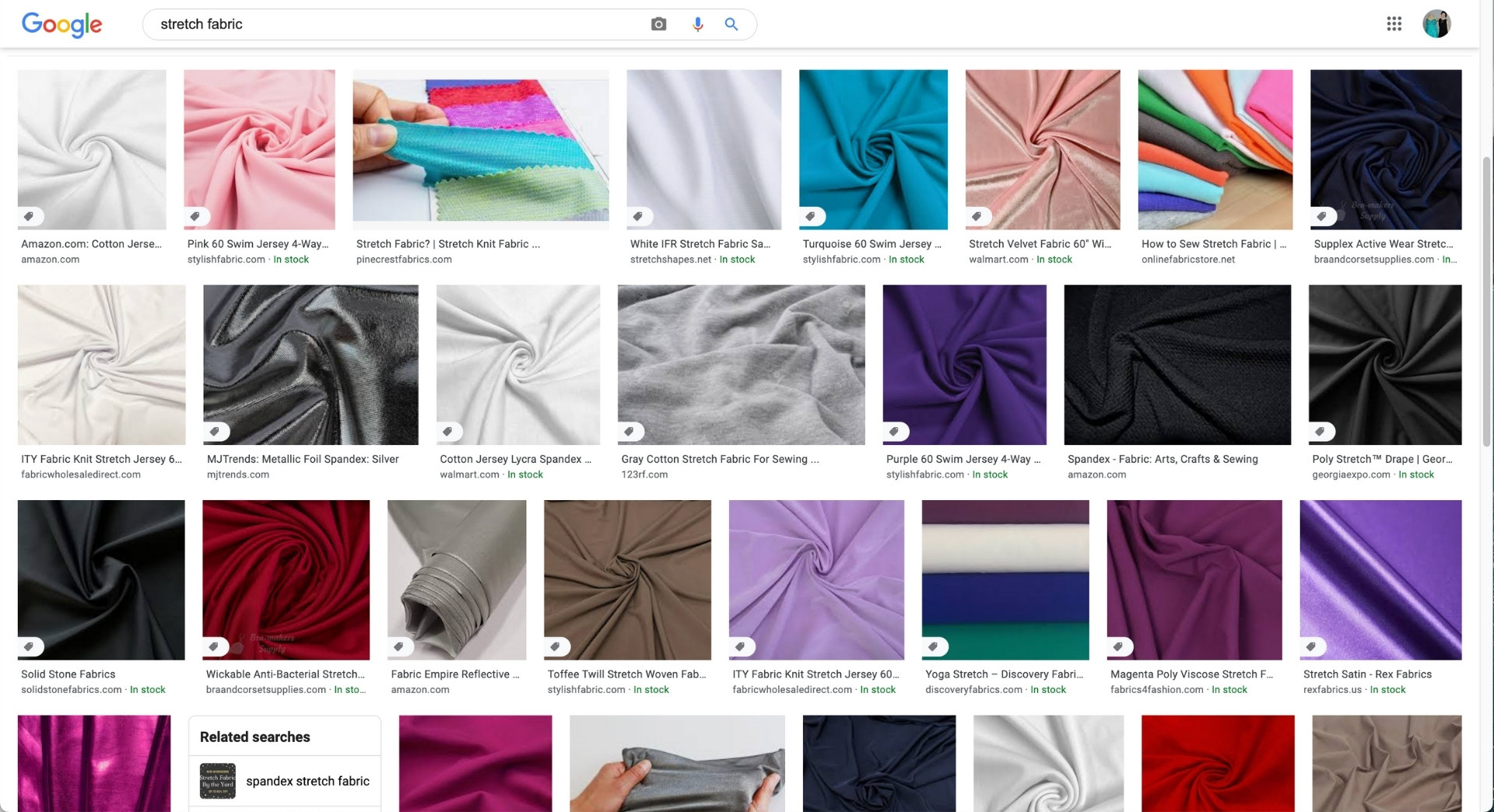 General stretch fabrics suitable for dance and skate costumes, including options for salsa dresses.
General stretch fabrics suitable for dance and skate costumes, including options for salsa dresses.
The golden rule? Always obtain fabric samples before committing to a large purchase. This allows you to test the stretch, drape, and color in person, ensuring it’s perfect for your salsa dress vision.
Understanding how to handle different stretch fabrics and adjust patterns accordingly is crucial for dressmakers. Mastering stretch fabric techniques is key to creating a salsa dancing dress that fits beautifully and moves flawlessly with you on the dance floor.
By carefully considering color, shine, fabric type, and stretch properties, you can select the perfect fabric to create a salsa dancing dress that not only looks spectacular but also enhances your confidence and performance.

